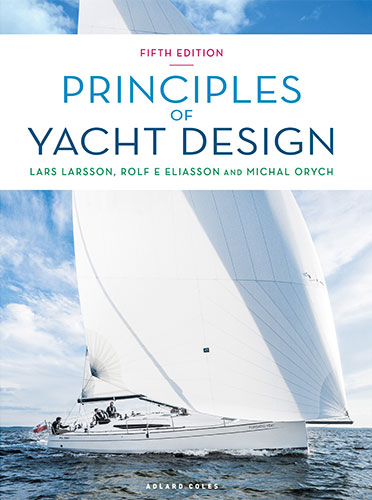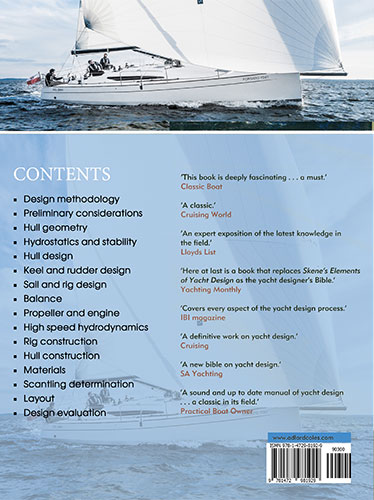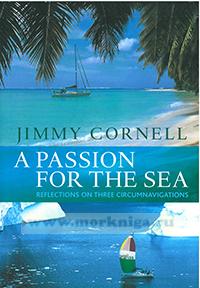Сб с 10 до 16
Principles of Yacht Design/Особенности проектирования яхт
Книга на английском языке.
Principles of Yacht Design has established itself as the standard book on the subject for practising designers, naval architecture students and discerning boat owners, as well as the boatbuilding industry as a whole. This fourth edition is wholly revised and expanded and follows the design from scratch of a completely new 41 foot performance cruiser to demonstrate the practical application of yacht design theory. As such, it examines every aspect of the process of yacht and powerboat design.
Contents
Preface to the Fifth Edition
List of Symbols
Introduction
1. Design methodology
- The design spiral
- Computer-aided design (CAD)
2. Preliminary considerations
- Choice of Poat-type
- Intended use
- Main dimensions.
- Cost
- Checklist of considerations
- Checklist for the YD-41
3. Hull geometry
- Definitions
- Lines drawing
- Tools
- Work plan
- Computer-aided design of hulls
4. Hydrostatics and stability
- Calculation of areas
- Wetted surface
- Displacement
- Centre of Puoyancy
- Water plane area
- Transverse and longitudinal stability at small angles
- Transverse stability at large angles of heel
- Curve of static stability
- Rolling
- Influence of waves on the righting moment
- Stability statistics
- Assessment of seaworthiness
5. Hull design
- Forces and moments on a sailing yacht
- Resistance components
- Viscous resistance: basic concepts
- Frictional resistance
- Viscous pressure resistance
- Roughness
- Wave resistance: basic concepts
- Wave and residuary resistance
- Heel resistance
- Added resistance in waves
- Other seakeeping aspects
- Hull statistics
6. Keel and rudder design
- Flow around a wing
- Definition of the keel planform
- Classical wing theory
- Tip shape
- Lift and induced resistance of the yacht
- Advanced planform design
- Canting keels
- Evaluation of some planform concepts
- Definition of the section
- Three useful NACA sections
- Influence of shape on section characteristics
- Some practical conclusions regarding section shape
- Influence of deviations from the theoretical section shape
- Advanced section design
- Statistics on keel and rudder area
- The YD-41
7. Foiling
- Foiling concepts
- Forces and moments
- Flight stability
- Planform area and shape
- Foil sections
- Example - a foiling skiff
- Computed forces
- Other aspects
8. Sail and rig design
- Flow around sails
- Planform
- Sail camber
- Mast interference
- Means for reducing mast disturbances
- Streamlining
- A practical model for sail and rig aerodynamics
- Sail statistics
9. Balance
- Effect of heel
- Good balance
- Centre of effort of the underwater body
- Centre of effort of the sails
- Lead
- Rudder balance
10. Propeller and engine
- Resistance in calm and rough weather
- Propeller characteristics
- Design of an optimum propeller
- Performance of the non-optimum propellei
- Check of blade area
- Propeller resistance
11. High speed hydrodynamics
- Planing
- Deadrise
- Forces on a planing hull
- Spray rails, stepped bottoms and transom flaps
- Dynamic stability
- Alternative propulsion devices
- An example
12. Rig construction
- Definitions and scope of the standard
- Forces on the shrouds
- Forces on the stays
- Comparison between wire and rod
- Transverse mast stiffness
- Longitudinal mast stiffness
- Fractional mast top
- Boom
-Spreaders
- Floles in the mast
- TheYD-4l rig
13. Hull construction
- Concepts in structural mechanics
- Global loads
- Local hydrostatic loads
- Local hydrodynamic loads
- Transverse load distribution
- Local deformations
- Forces from the keel
- Forces from grounding
- Forces from the rudder
- Summary of loadings
14. Materials
- Glass reinforcement
- Wet laminates
- Fatigue
- Exotic laminates
- Sandwich
- Typical sandwich buckling
- Sandwich bending
- Sandwich in practice
- Final remarks
15. Scantlings
- Determination
- Structure of the standard
- Hull definitions
- Areas
- Dimensions of panels and stiffeners
- Pressures on panels and stiffeners
- Pressure adjusting factors
- Design loads
- Design loads for the topsides
- Design loads for the decks, superstructures and bulkheads
- Summary of design loads
- Mechanical properties and design stresses
- Boatbuilding quality factor Kbb
- Assessment method factor Kam
- Aspect ratio factors for plating K2b and Ksh
- Curvature correction factor for plating Kc
- Design stresses
- Design shear forces and design moments Fd and Md
- Methods for scantling determination
- Determination of mechanical properties
- Single skin panel calculation
- Sandwich
- Stiffener design forces and moments
- Stiffener curvature factor Kcs
- Stresses in stiffeners and crit
- Effective width of attached plating Be
- Stiffener contruction
- Spade rudder stock
- Keelbolts
- Rig loads and rig attachment
16. Layout
- Generic space requirements
- Accommodation
- Deck layout
- Building the YD-41
17. Design evaluation
- Non-dimensional parameters
- The Velocity Prediction Program (VPP)
- Towing; tank testing
- Wind tunnel testing
- Computational Fluid Dynamics (CFD)
Appendix 1: Main particulars of theYD-41
Appendix 2: Weight calculation
Appendix 3: STIX calculation
References
Index




 A Passion for the Sea
A Passion for the Sea